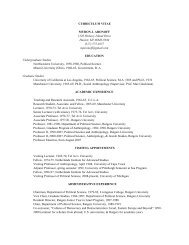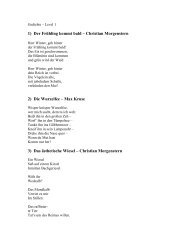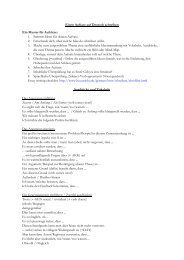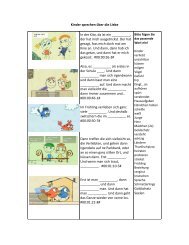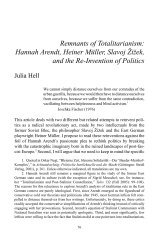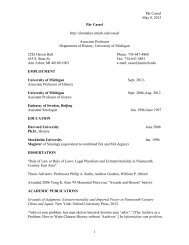Remember the Hand: Bodies and Bookmaking in Early Medieval ...
Remember the Hand: Bodies and Bookmaking in Early Medieval ...
Remember the Hand: Bodies and Bookmaking in Early Medieval ...
You also want an ePaper? Increase the reach of your titles
YUMPU automatically turns print PDFs into web optimized ePapers that Google loves.
Downloaded by [ca<strong>the</strong>r<strong>in</strong>e brown] at 13:48 24 October 2011<br />
Figure 3. Madrid, Real Academia de la Historia, MS 29, f. 273v. (detail). ‘‘<strong>Remember</strong> Aloysius <strong>the</strong> presbyter’’<br />
[ALOITII PRESBITERI MEMORIA].<br />
beg<strong>in</strong>n<strong>in</strong>g <strong>and</strong> <strong>the</strong> end, saith <strong>the</strong> Lord God, who is, <strong>and</strong> who was, <strong>and</strong> who is to<br />
come’’. 20 Once our memory has thus glossed <strong>the</strong> Alpha with <strong>the</strong> Biblical passage,<br />
<strong>the</strong> codex is cast <strong>in</strong>to Apocalyptic time, over which rules Christ <strong>in</strong> Majesty. There<br />
he is, opposite <strong>the</strong> Alpha, on <strong>the</strong> fac<strong>in</strong>g page’s apo<strong>the</strong>osis of <strong>the</strong> Book (f. 2r). Turn<br />
<strong>the</strong> page to 2v <strong>and</strong> <strong>the</strong>re Christ is aga<strong>in</strong>---represented alphabetically by his<br />
monogram, <strong>the</strong> chrismon, from <strong>the</strong> arms of which dangle <strong>the</strong> alpha <strong>and</strong> omega<br />
that represent him metaphorically. Fac<strong>in</strong>g this page is <strong>the</strong> alphabetic labyr<strong>in</strong>th<br />
that evokes <strong>the</strong> unworthy scribe Florentius <strong>and</strong> <strong>in</strong>terpellates his faithful reader.<br />
Perhaps <strong>the</strong> unfold<strong>in</strong>g harmonies of this <strong>in</strong>vocation evoked <strong>the</strong> glorious spread of<br />
<strong>the</strong> peacock’s tail on f. 3v (fac<strong>in</strong>g an expensive blank page) as much as did <strong>the</strong><br />
bird’s proverbial association with <strong>the</strong> beauties of scripture. 21<br />
Florentius’s Moralia beg<strong>in</strong>s with Alpha <strong>and</strong> ends 501 folios later with Omega<br />
(for <strong>the</strong> clos<strong>in</strong>g sequence, see table 3). 22<br />
Before that last letter can close <strong>the</strong> book, however, Florentius has some<br />
th<strong>in</strong>gs to say. On f. 499r, Florentius beg<strong>in</strong>s his end<strong>in</strong>g thus:<br />
Here ends <strong>the</strong> Moralia of Pope Gregory <strong>the</strong> Roman, era 983 [=945 CE], Friday,<br />
April [11 th ] <strong>in</strong> <strong>the</strong> Easter season, at prime. In <strong>the</strong> reigns of K<strong>in</strong>g Ramiro <strong>and</strong><br />
count Fern<strong>and</strong>o <strong>and</strong> bishop Basilio. Blessed be <strong>the</strong> k<strong>in</strong>gdom of heaven which has<br />
permitted me to reach <strong>the</strong> end of this book safely. AMEN. 23<br />
[Explicit liber moralium Gregorii romensis pape era DCCCCLXXXIIIa [III] idus<br />
aprilis VI feria pasce hora prima. deo gratias. regnante rex Ranemiro et comite<br />
Freden<strong>and</strong>o necnon et Basilio episcopo. Benedicto caeli quoque regem me qui<br />
ad istius libri f<strong>in</strong>em uenire permisit <strong>in</strong>colomem. AMEN.]<br />
This conclusion is followed by <strong>the</strong> shock<strong>in</strong>g silence of two fac<strong>in</strong>g pages left<br />
expensively blank. Then you turn <strong>the</strong> page <strong>and</strong> encounter ano<strong>the</strong>r two-page<br />
spread: a full-page colophon on <strong>the</strong> left (f 500v, Color Plate 2) <strong>and</strong> <strong>the</strong> Omega<br />
on <strong>the</strong> right (501r).<br />
This second colophon is very carefully lettered <strong>and</strong> laid out: a full-page<br />
composition (remember how big <strong>the</strong>se pages are!) made up of two major text<br />
blocks, each written <strong>in</strong> alternat<strong>in</strong>g l<strong>in</strong>es of black <strong>and</strong> red display uncials,<br />
framed with a border of <strong>in</strong>terlace <strong>and</strong> trompe-l’oeil cubes <strong>and</strong> squares. The<br />
268 CATHERINE BROWN<br />
Figure 2. Madrid, Real Academia de la<br />
Historia, MS 29, f. 170v (detail). ‘‘<strong>Remember</strong><br />
Moterrafe <strong>the</strong> deacon’’ [MEMORIA<br />
DIACONUM MOTERRAFE].<br />
Figure 4. Madrid, Real Academia de la<br />
Historia, MS 29, 276v. (detail). ‘‘Here<br />
Aloysius <strong>the</strong> presbyter stopped writ<strong>in</strong>g’’<br />
[‘‘Hic cessavit Aloitius presbiter de scribere’’].<br />
20 – (Apoc 1.8, Douay).<br />
21 – Cassiodorus compares <strong>the</strong> Psalms to <strong>the</strong><br />
peacock’s fanned tail <strong>in</strong> Institutiones I.iv.3. That<br />
early Iberian bookmakers were aware of this<br />
connection is attested by <strong>the</strong> peacocks accompany<strong>in</strong>g<br />
Psalms 85 <strong>and</strong> 126 <strong>in</strong> a copy of<br />
Cassiodorus’s Commentary on <strong>the</strong> Psalms made<br />
at San Millán <strong>in</strong> <strong>the</strong> late tenth century<br />
(Madrid, Real Academia de la Historia MS 8).<br />
22 – On this common practice <strong>in</strong> Iberian<br />
luxury codices of <strong>the</strong> period, see Mentre,<br />
Illum<strong>in</strong>ated Manuscripts, pp. 97-8.<br />
23 – Text from Manuel C. Díaz y Díaz, ‘‘Los<br />
prólogos y colofones de los códices de<br />
Florencio,’’ <strong>in</strong> Códices visigóticos en la monarquía<br />
leonesa (León: Centro de Estudios de<br />
Investigación ‘San Isidoro,’ 1983), p. 516.<br />
Though Florentius’s two colophons from MS<br />
80 are often cited, <strong>the</strong> entire text has never, to<br />
my knowledge, been published <strong>in</strong> translation.<br />
I have supplied <strong>the</strong> date <strong>in</strong> April (<strong>the</strong> 11th)<br />
from Florentius’s second colophon, where he<br />
gives <strong>the</strong> date as ‘‘III idus aprilis’’ (f. 500v.). He<br />
omitted <strong>the</strong> ‘‘iii’’ here, perhaps misled by <strong>the</strong><br />
three ‘‘I’’s at <strong>the</strong> end of <strong>the</strong> year 983.







